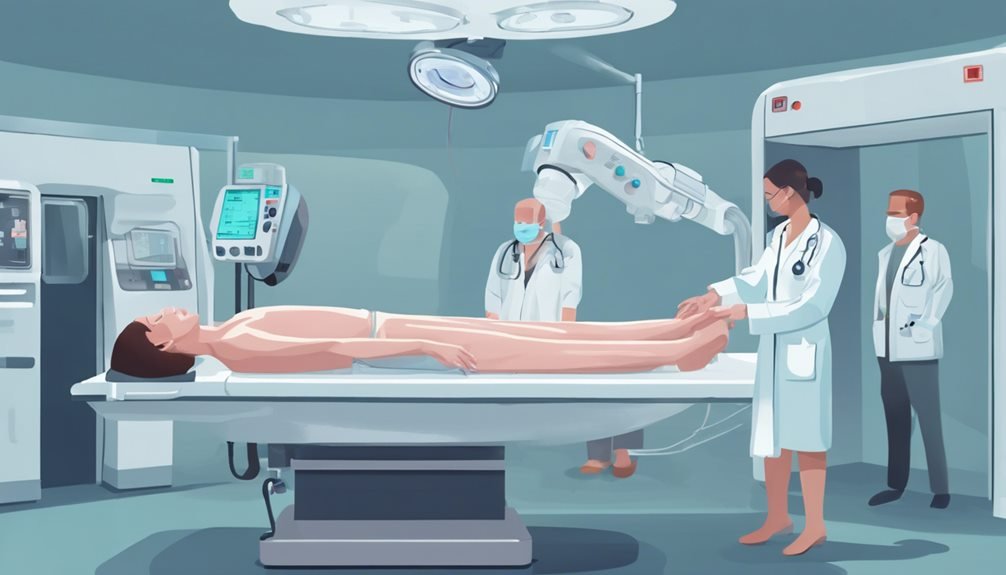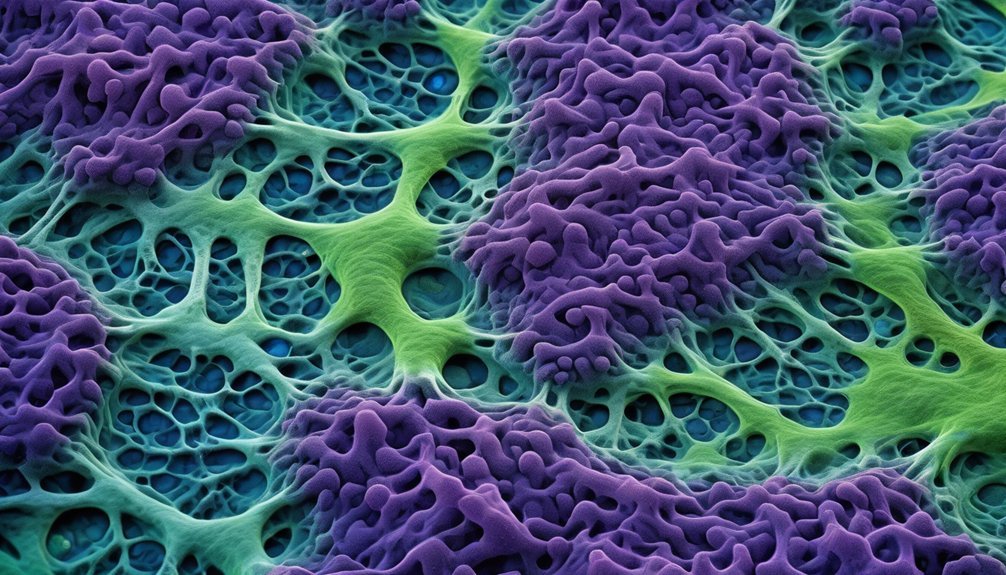Imagine a treatment that can target cancer cells specifically, offering a focused approach to combating the disease. Hyperthermia in natural cancer treatment does just that by utilizing elevated temperatures to disrupt cancer cell function. But what exactly does this mean for the future of cancer care? Stay tuned to uncover the intricacies of hyperthermia therapy, its benefits, safety considerations, and how it stands against conventional cancer treatments. The road to understanding hyperthermia's role in oncology is just beginning.
Key Takeaways
- Hyperthermia in cancer treatment applies heat to target and damage cancer cells selectively.
- Natural hyperthermia therapy disrupts tumor growth mechanisms and enhances treatment effectiveness.
- Utilizes heat to induce tumor cell death and boost the immune system for holistic cancer care.
- Integrating hyperthermia with traditional treatments improves outcomes and minimizes side effects.
- Safety is ensured through healthcare supervision, with well-tolerated sessions for improved patient comfort.
Understanding Hyperthermia in Cancer Treatment
When considering the approach of hyperthermia in cancer treatment, it's crucial to understand the fundamental principles behind this method.
Thermoregulation in cancer refers to the body's ability to maintain its internal temperature within a narrow range despite external temperature changes. In cancer, this regulation can be disrupted, leading to the potential for exploiting heat stress in tumors as a therapeutic strategy.
Heat stress in tumors occurs when temperatures rise, causing cellular damage and inducing a cascade of events that can ultimately lead to tumor cell death.
Understanding the intricacies of thermoregulation and the effects of heat stress on tumors is essential in harnessing hyperthermia for cancer treatment. By carefully manipulating temperatures in targeted areas, hyperthermia can selectively damage cancer cells while minimizing harm to healthy tissues.
This focused approach holds promise for patients seeking treatments that aren't only effective but also considerate of their overall well-being.
How Hyperthermia Targets Cancer Cells
Hyperthermia targets cancer cells through the precise application of elevated temperatures to specifically damage malignant tissue while sparing surrounding healthy cells. This cellular targeting is achieved by carefully modulating the temperature in the affected area to induce stress and ultimately destroy cancer cells.
Cancer cells are known to be more sensitive to heat than normal cells, making them more vulnerable to the effects of hyperthermia therapy. The concept behind hyperthermia's effectiveness lies in the ability to disrupt the specific biological processes that are crucial for cancer cell survival. By elevating the temperature in a controlled manner, hyperthermia can interfere with the cellular mechanisms that support tumor growth while minimizing harm to healthy tissues.
This targeted approach reduces the risk of side effects commonly associated with traditional cancer treatments like chemotherapy and radiation therapy. Through temperature modulation and precise cellular targeting, hyperthermia offers a promising strategy for combating cancer while prioritizing the well-being of the individual. The potential of hyperthermia to selectively eradicate cancer cells showcases its value in the realm of natural cancer treatment.
Benefits of Hyperthermia Therapy

To fully grasp the benefits of hyperthermia therapy in the context of natural cancer treatment, it's imperative to understand how this innovative approach can positively impact individuals battling cancer. Heat benefits and therapy advantages combine to offer a holistic approach to cancer treatment, providing hope and relief to those undergoing the therapy.
Here are four key benefits of hyperthermia therapy:
- Enhanced Effectiveness: By elevating the temperature in the targeted area, hyperthermia enhances the effectiveness of other cancer treatments like chemotherapy and radiation therapy, leading to better outcomes for patients.
- Immune System Boost: Hyperthermia can help stimulate the immune system, making it more effective in fighting cancer cells and reducing the risk of recurrence.
- Minimized Side Effects: Compared to traditional cancer treatments, hyperthermia therapy often results in fewer side effects, improving the overall quality of life for patients.
- Tumor Shrinkage: The heat from hyperthermia can directly lead to tumor shrinkage, providing relief from symptoms and potentially improving long-term prognosis.
Different Types of Hyperthermia Techniques
Exploring the realm of hyperthermia techniques unveils a diverse landscape of approaches aimed at effectively treating cancer through targeted heat application. Various types of hyperthermia techniques are utilized in natural cancer treatment, each with its unique method of heat application and temperature control mechanisms.
One common method is external hyperthermia, where heat is applied to the body from an external source such as microwave, ultrasound, or infrared devices. This technique allows for precise targeting of cancer cells while minimizing damage to surrounding healthy tissues.
Another approach is internal hyperthermia, where heat is applied directly to the tumor site using probes or catheters. This method ensures that the heat reaches deep into the tumor, enhancing its effectiveness in destroying cancer cells.
Additionally, regional hyperthermia involves heating a specific region of the body, such as an organ or limb, to target localized tumors effectively.
Hyperthermia vs. Traditional Cancer Treatments

In the realm of cancer treatment, the comparison between hyperthermia and traditional treatments holds significant importance for patients seeking effective solutions. When evaluating hyperthermia efficacy versus traditional treatments, here are some crucial points to consider:
- Hyperthermia's Targeted Approach: Hyperthermia selectively targets cancer cells, potentially minimizing damage to healthy tissues compared to conventional treatments like chemotherapy.
- Survivability Rates: Studies suggest that hyperthermia, when used in conjunction with other therapies, may improve survival rates for certain types of cancer when compared to traditional treatments alone.
- Side Effects: Hyperthermia may have milder side effects than traditional treatments such as radiation or chemotherapy, leading to a better quality of life during and post-treatment.
- Comprehensive Approach: Integrating hyperthermia with traditional treatments can offer a more comprehensive approach, potentially enhancing the overall effectiveness of the cancer treatment plan.
Mechanism of Action in Hyperthermia
The mechanism of action in hyperthermia involves the controlled application of heat to raise the temperature of cancerous tissues, aiming to damage or destroy cancer cells while minimizing harm to healthy cells. Heat delivery plays a crucial role in this process, as cancer cells are known to be more sensitive to elevated temperatures than normal cells. When exposed to heat, cancer cells undergo a series of cellular responses that ultimately lead to their demise.
One key cellular response is protein denaturation, where the heat causes proteins within the cancer cells to unfold and lose their function, disrupting essential cellular processes. Additionally, the increased temperature can induce oxidative stress, leading to the production of reactive oxygen species that further damage the cancer cells. By precisely targeting cancerous tissues with heat, hyperthermia offers a therapeutic approach that selectively eradicates cancer cells while sparing healthy surrounding tissues, offering hope for those seeking effective and compassionate cancer treatment options.
Clinical Applications of Hyperthermia

Pioneering advancements in cancer treatment have embraced hyperthermia as a promising modality with significant clinical applications. Hyperthermia has been extensively studied in hyperthermia clinical trials, with compelling results showing its efficacy in treating various types of cancers.
Some key points to consider include:
- Improved Treatment Efficacy: Hyperthermia, when combined with traditional therapies like chemotherapy or radiation, has shown enhanced treatment outcomes, leading to better tumor control and increased survival rates.
- Reduced Side Effects: Clinical trials have demonstrated that hyperthermia treatment outcomes include a reduction in the side effects often associated with conventional cancer treatments, improving the overall quality of life for patients.
- Enhanced Tumor Response: Studies have revealed that hyperthermia can improve tumor response rates, making cancer cells more susceptible to other treatment modalities, ultimately increasing the chances of successful therapy.
- Personalized Treatment Approach: Hyperthermia allows for a more personalized treatment approach, tailored to the individual patient's needs, offering hope and improved outcomes for those battling cancer.
Combining Hyperthermia With Other Therapies
Combining hyperthermia with other cancer therapies can significantly enhance treatment outcomes and improve patient prognosis. When considering hyperthermia combinations, integrating this therapy with chemotherapy has shown promising results. Hyperthermia can increase the effectiveness of chemotherapy by improving drug delivery to the tumor site and enhancing the sensitivity of cancer cells to the chemotherapy agents.
Additionally, combining hyperthermia with radiation therapy, known as thermoradiotherapy, has been found to enhance the effects of radiation on cancer cells, leading to better tumor control.
Furthermore, hyperthermia can also be integrated with immunotherapy, a treatment that boosts the body's immune response against cancer cells. By combining hyperthermia with immunotherapy, the immune system can be stimulated to better recognize and target cancer cells, potentially enhancing the overall treatment efficacy.
These hyperthermia combinations offer a comprehensive approach to cancer treatment, targeting cancer cells through different mechanisms simultaneously. By integrating hyperthermia with other therapies, healthcare providers can offer patients a more personalized and effective treatment strategy, ultimately improving patient outcomes and quality of life.
Safety and Side Effects of Hyperthermia

To understand the implications of hyperthermia in cancer treatment fully, it's imperative to consider the safety profile and potential side effects associated with this therapeutic approach. When considering hyperthermia as part of cancer treatment, it's essential to prioritize the well-being and comfort of the patient. Here are some crucial points to keep in mind:
- Safety considerations: Hyperthermia treatment should be conducted under the supervision of trained healthcare professionals to ensure it's administered safely and effectively.
- Side effects: While generally well-tolerated, hyperthermia may cause side effects such as skin redness, discomfort, or fatigue, which should be monitored and managed appropriately.
- Efficacy assessment: Regular evaluation of the treatment's efficacy is necessary to track progress and make any necessary adjustments to optimize outcomes.
- Patient comfort: Ensuring the patient's comfort throughout the hyperthermia session is paramount, as it can contribute to their overall well-being and treatment experience.
Research and Studies on Hyperthermia
Over the past few decades, researchers and medical professionals have conducted numerous studies and clinical trials to investigate the efficacy and safety of hyperthermia as a complementary treatment for cancer. Hyperthermia research has shown significant advancements, highlighting its potential in cancer care.
Clinical trials focusing on hyperthermia have produced promising outcomes, demonstrating its ability to enhance the effects of traditional cancer treatments like chemotherapy and radiation therapy. These studies have indicated that hyperthermia can help make cancer cells more susceptible to treatment while potentially reducing the side effects associated with conventional therapies.
Researchers are continuously exploring new ways to optimize hyperthermia techniques, such as targeted heating methods and personalized treatment plans, to improve patient outcomes. By delving into the realm of hyperthermia research, scientists are paving the way for innovative approaches to cancer treatment that prioritize both efficacy and patient well-being.
Integrating Hyperthermia Into Cancer Care

Enhancing the landscape of cancer care involves integrating hyperthermia as a strategic component in treatment protocols. Hyperthermia benefits patients by complementing traditional therapies, such as chemotherapy and radiation, leading to improved outcomes. When considering cancer integration, here are four essential aspects to keep in mind:
- Holistic Approach: Incorporating hyperthermia into treatment plans allows for a more comprehensive and personalized care strategy, addressing not only the physical symptoms but also the emotional and mental well-being of the patient.
- Enhanced Efficacy: By combining hyperthermia with conventional treatments, the therapeutic effects can be synergized, potentially increasing the overall effectiveness of the cancer treatment regimen.
- Minimized Side Effects: Hyperthermia can help reduce the toxicity and side effects associated with certain cancer treatments, leading to a better quality of life for patients undergoing therapy.
- Patient-Centered Care: Integrating hyperthermia demonstrates a commitment to patient-centered care, ensuring that individuals receive tailored treatment plans that consider their unique needs and preferences.
Future Outlook for Hyperthermia in Oncology
As we look towards the future of oncology, the role of hyperthermia continues to evolve as a promising adjunct to traditional cancer treatments. Hyperthermia advancements and innovations open new possibilities for improving patient outcomes and quality of life.
| Future Outlook for Hyperthermia in Oncology | |
|---|---|
| 1. Personalized Therapies | 4. Targeted Delivery Systems |
| Tailoring hyperthermia treatments based on individual patient characteristics can enhance efficacy and reduce side effects. | Advancements in targeted delivery systems allow for precise heating of tumor tissues while minimizing damage to surrounding healthy cells. |
| 2. Combination Therapies | 5. Immunomodulatory Effects |
| Combining hyperthermia with other treatments like chemotherapy or immunotherapy can lead to synergistic effects, improving overall treatment outcomes. | Hyperthermia's ability to modulate the immune response shows promise in enhancing the body's natural defenses against cancer cells. |
| 3. Technological Enhancements | 6. Clinical Trial Expansion |
| Ongoing technological developments aim to enhance the precision and effectiveness of hyperthermia treatments, paving the way for more widespread adoption in oncology. | The expansion of clinical trials exploring hyperthermia's role in various cancer types will provide further insights into its efficacy and safety. |
Frequently Asked Questions
Can Hyperthermia Be Used for All Types of Cancer?
Yes, hyperthermia can be a targeted therapy for various types of cancer. It works by raising the temperature of the tumor, enhancing treatment effectiveness. While not suitable for all cancers, it can complement other treatments like chemotherapy and radiation.
Hyperthermia helps sensitize cancer cells to treatment, potentially improving outcomes. Discuss with your healthcare team to see if hyperthermia is a viable option for your specific cancer type.
How Long Does a Hyperthermia Treatment Session Last?
During a hyperthermia treatment session, the duration typically ranges from 1 to 2 hours. This timeframe allows for the targeted heating of cancer cells while minimizing discomfort to the patient.
The effectiveness of hyperthermia in cancer treatment has been studied extensively, showing promising results. Patients may experience mild side effects such as skin redness or warmth, but overall, the procedure aims to enhance traditional cancer treatments and improve outcomes with patient comfort in mind.
Are There Any Dietary Restrictions Before Hyperthermia Therapy?
Before hyperthermia therapy, it's crucial to adhere to pre-treatment preparation guidelines, including dietary considerations. You should avoid certain foods that can affect the body's response to the therapy. Typically, it's recommended to limit intake of caffeine, alcohol, and spicy foods.
Focus on a balanced diet rich in fruits, vegetables, and lean proteins to optimize the effectiveness of hyperthermia treatment. Consulting with your healthcare provider for personalized dietary advice is advisable.
Is Hyperthermia Therapy Covered by Health Insurance?
Like a puzzle piece fitting perfectly, insurance coverage for hyperthermia therapy varies based on providers and policies. Cost considerations play a significant role in accessing this treatment. Understanding the nuances of coverage can impact treatment effectiveness and patient outcomes.
Investigate your insurance plan to unveil potential coverage for this innovative therapy. Your diligence may unlock a path to receiving this valuable treatment without financial burdens.
What Qualifications Should a Hyperthermia Therapist Have?
To ensure patient comfort and safety, a hyperthermia therapist should have extensive training and accreditation. Look for therapists with certifications in hyperthermia treatment from reputable institutions. They should be knowledgeable about the latest techniques and safety protocols.
Additionally, a qualified therapist should have experience working with cancer patients, showing compassion and understanding. Prioritize finding a therapist who's dedicated to providing excellent care and support throughout the treatment process.
Conclusion
Now that you've delved into the world of hyperthermia in natural cancer treatment, you can appreciate its targeted approach to combating cancer cells. Like a skilled archer aiming for the bullseye, hyperthermia delivers precise heat to destroy tumors while sparing healthy tissue. With ongoing research and advancements in technology, the future holds great promise for integrating hyperthermia into mainstream oncology practices. Keep your sights set on this innovative therapy for a brighter future in cancer care.





